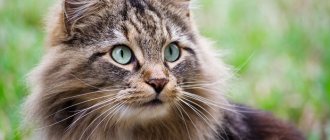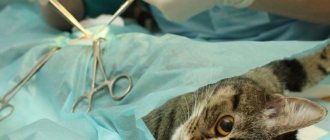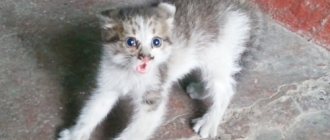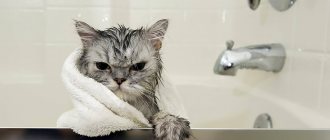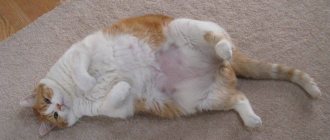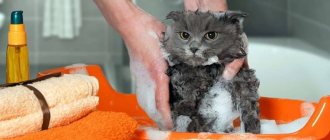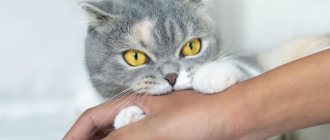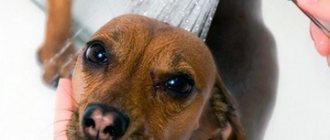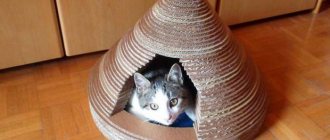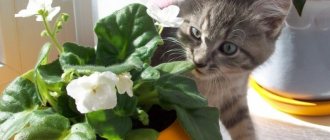What kind of exhibitions are there?
Each association has its own rules and nuances for holding exhibitions, which cat breeders should familiarize themselves with in advance. Events are divided by type of judging. Each system also has its own conditions for obtaining a title and form of membership. Main types of exhibitions:
- American;
- British;
- European.
Each cat show is held according to a specific system.
In rare cases, you can find a mixed system. In order to understand what type of event is suitable in this case, it is necessary to delve into the details of each type of exhibition. The purpose of the system is to determine whether the pet meets the breed standard. This is important for a breeder if he plans to breed a certain type of cat. At the same time, experts evaluate the pet according to a number of parameters that it must meet.
For an animal, an exhibition is a lot of stress, so it is important to carefully prepare the cat for the upcoming event, especially if the animal never leaves the house and is afraid of strangers.
European system
The European version involves individual judging, in which everything is recorded in writing. For these purposes, the appraiser is provided with a special form with characteristics, which must be filled out after examining the pet. The cat is brought to the judge by a trained person, not the owner himself. This rule allows you to maintain anonymity. This system can protect the animal from a number of infections, since after each pet the table is wiped with disinfectants, and the appraiser treats his hands with an antiseptic.
At the end of the event, the cat's owner takes the ratings and description of the breed, which remain in his hands. Registration is carried out only by club members who are logged into the system. Title registration is also carried out only for those who have joined the community. During the evaluation of the cat, only an assistant is allowed next to the judge. Third parties excluded. To receive a certain title, a cat must be evaluated by three judges. The participant must be at least three months old to qualify for the award.
At the end of the exhibition, the cat can receive an honorary title
In order to receive a high title, you need to participate in events that are held in different countries. List of European subsystems:
- WCF - the cat must receive an assessment, as well as honorary titles at the end of the event, if available, the corresponding certificate can be issued;
- FIFe - includes the “best in color” competition, following which the animal can take part in “Best in show” - an honorary competition for those who have succeeded in other categories;
- FARUS - the subsystem is similar in rules to WCF, but has some characteristics of the American system - ring competition;
- MFA - only animals of the same breed, color, sex and show class can compete;
- WACC - the breed is assessed according to certain categories, the cat can receive the title “World Champion” or “European Champions”;
- OFA - this subsystem is similar to all of those listed, it implies strict veterinary control, the assessment can be made by one judge or several at once.
The European system is the most common of all and requires a mandatory fee for participation.
American
This system provides for passing the examination in one day, which greatly simplifies the task compared to the European type of event. Animals that are at least four months old are allowed to participate. Registration can take place directly, without involving the club. A special feature of this system is the assessment of a group of cats at once. In addition to the judges, anyone can attend.
Exhibitions according to the American system are like a performance, the participants of which can be followed by everyone
The group of pets for evaluation must consist of representatives of the same breed and color. The description of the animal, unlike the European system, is oral. In addition, all titles can be closed in one region, which is also very convenient for the breeder. Subtypes of the American system:
- CFA - there is a special coding system for the animal’s breed, and the gender and genetics of the pet are also taken into account;
- TICA - documents for participation can be submitted by e-mail, there is no title division (classified depending on age);
- ICU - there is a separate class for neutered pets, the color of the ribbon (award) means what place the pet took in the competition;
- WCA - almost identical to the CFA system, it is preferable for those breeders who intend to sell pets abroad;
- RUI is an almost identical system to the ones listed above. Several judges evaluate the animals at once, and everyone who wishes follows the progress of the competition. However, if the pet is aggressive, it will be disqualified;
- The CFF is one of the oldest American systems, the rules of which are quite strict, but this reduces the risk of unfair judging. Each expert selects the 10 best pets in his ring.
The American system is more spectacular, reminiscent of a show, which is why many breeders prefer it. However, for fearful and irritable pets, such a competition will be a real test.
British
To participate in an event using the British system, you must be a member of one of the clubs. The same algorithm is used to design the animal. During the exhibition, all pets are placed in separate cages, and the breeders leave the hall. The appraiser, together with an assistant, makes a description of the breeds, taking into account even the slightest discrepancies. The breeder receives the conclusion in writing on the second day after the event.
The British show system involves placing cats in separate cages
Judges do not evaluate groups of pets, but individual breeds. After the examination, the hall is opened to everyone. The award ceremony takes place on stage.
The British system is used very rarely and is less in demand compared to the European and American ones.
Cat Show Systems
All cat exhibition systems are divided into 3 types:
- European
- American
- British
Each system differs in judging methods, show classes, titles and much more.
European system
The wcf system is one of the European ones, which is currently considered the most popular in Russia. It is known for the fact that its experts are relatively loyal to new breeds and quickly recognize them. In addition, according to the wcf system, the cat is accompanied by the owner throughout the entire exhibition, which, you see, is important for a pet.
The American exhibition system is distinguished by the fact that experts do not evaluate cats on tables. There are rings where cats are described verbally. And instead of evaluation sheets, participants in such exhibitions are given ribbons called ribbons. According to the American version, systems such as tica, cfa, cff, icu, rui and wca work.
British system
The British system is not as popular as the European and American ones. There is only one system here - gccf, which evaluates cats sitting in cages.
Classes, titles and awards - table
| Class | Titles | Awards |
| Champions | "International Champion" |
|
| World Champions | "Breed Winner" | |
| Grand European Champions | "World champion" | |
| European Champions | "Grand Champion of Europe" | |
| Grand International Champions | "European Champion" | |
| International Champions | "International Grand Champion" | |
| World Premiers | "Breed winner among castrati" | "Best Neuter in Show" |
| European Premiers | "Grand Champion of Europe" | |
| Great European Premiers | "Best in show among castrati" | |
| Grand International Premiers | "Premier of Europe" | |
| International Premiers | "International Grand Premier" | |
| Premiers | "International Premier" | |
| Castrati class | "Premier" | |
| Open class | "Champion" | "Best of Breed" |
| Class of kittens aged 6 to 10 months | "Breed winner among young 6–10 months" | "Best Junior 6–10 months on show" |
| Class of kittens aged 3 to 6 months | “Breed winner among kittens 3–6 months old” | "Best kitten 3-6 months in the show" |
| Littper class | "Best litter" | "Best Litter in Show" |
| Beginners | — | — |
| Determination of color | — | — |
| Domestic cats | "Best domestic cat (cat)" |
|
Drying
First, the cat must be blotted with a towel, treated with an antistatic agent and dried with a hairdryer, while styling it so that the fur does not get tangled and gets volume.
Work progress:
- Paws. Using a brush, the wool is lifted from the bottom up, drying the base of the coat.
- Collar. The fur must be pulled back with a comb to make it straight and smooth.
- Muzzle.
- Back. Comb against the grain.
- Pants and belly. The wool is pulled down.
Light wool is powdered to avoid contamination, then the excess is blown out with a hairdryer.
We suggest you read: Why does the cat always ask for food? The cat constantly asks for food
It is recommended to drop Visine into the animal's eyes - this will relieve irritation.
Conditions of participation in the exhibition
To participate in the exhibition, you need to fulfill certain conditions, as well as prepare the necessary documents. The animal’s health status and age must be taken into account. In addition, you need to be prepared for the fact that you will have to contribute a certain amount to participate in the competition. The cost depends on the competition system and additional nuances that should be clarified with the organizer.
Pet age
In order to take part in the exhibition, the kitten must be over 3-4 months old (depending on the system). If the pet is younger than the stated age, then it can be counted as part of the litter and must be with its mother. There is no set upper limit. If desired, older cats can also participate in the competition, but such pets have less chance of winning.
Kittens under 3–4 months are not allowed to participate in the competition.
If you plan to breed the breed in the future, it is recommended to take an animal older than 10 months to the exhibition.
Health status
Before the competition, your pet must be vaccinated against rabies, rhinotracheitis, panleukopenia and calicivirosis. This should be done no later than 4 weeks and no earlier than 12 months before the start. Deworming is a prerequisite. For this purpose, the animal must be given anti-worm medication a month before the event.
Before the start of the competition, cats and female cats must be vaccinated
Cats with intact skin and coat are allowed to participate. If the pet is injured, then you should refrain from such an event. The same applies to animals with congenital defects: strabismus, blindness, cleft lip, etc. Pregnant and lactating pets can participate in the event, but some conditions are also provided for them.
A pregnant cat can participate in the competition, but only at the initial stage
Firstly, the cat must have no obvious signs of lactation (large and swollen nipples). Theoretically, the pet will be admitted to the competition, but will lose points if this condition is neglected. Participation in competitions is possible only in the early stages of pregnancy, when the animal’s belly is invisible. Spayed and neutered pets are allowed only to certain exhibition classes provided for in this case.
Another important point to pay attention to is the behavior of your furry friend. If the cat does not have a calm disposition, then it is not recommended to take part in the exhibition, since the pet can be disqualified for hissing, biting and fighting with competition participants.
An aggressive pet may be disqualified
Attention! Cats with injuries, lameness or other external defects cannot participate in the exhibition.
Documents that will be required
Documents that need to be prepared:
- Vet passport. Such a document is an admission to the exhibition and must contain information about all vaccinations of the animal.
- Help No. 1. This document contains information about the sanitary conditions of the area of residence. Such a certificate will be required to participate in a competition held in another region, city or country.
- Help No. 4. This paper is issued by a doctor on the basis of a veterinary passport and after examining the pet. This is a kind of conclusion about the health of the animal.
- Application for participation. It must be submitted in advance, at least a month in advance. You need to find out about registration deadlines directly by phone or on the organizer’s official website.
To participate in the exhibition you will need a veterinary passport
Additionally, it is recommended to prepare a kitten purchase and sale agreement, birth certificate and pedigree. Organizers may request such documents. Additional information that may be required must be clarified in advance to avoid getting into an awkward situation.
First time at the exhibition: tips for beginners
This article describes general information on how to prepare not only British cats, but also cats of other breeds for an exhibition. It's no secret that at many Russian exhibitions poorly prepared, shedding, overfed and even unhealthy animals are presented. And it is very disappointing when a representative of such animals demonstrates them as an excellent breed type.
It seems that their owners paid $1,000 for the kitten and now believe that for that price the animal should prepare itself for the exhibition event.
But seriously, there is very little literature that gives competent advice for preparing a cat for an exhibition. Many periodicals have published materials on the training of only Persian cats, which is why owners of other cat breeds begin to think that they can take their pets to an exhibition at any time.
Many owners, deprived of information, follow illiterate advice or use the described preparation of Persian wool on their animal of another breed - many experts are faced with powdered Angoras and combed Siberians!
In addition, local felinological organizations do not inform owners that poor preparation for the exhibition can lead to deprivation of the title or cause a lack of nomination in Best in Show. And in the end, they begin to make claims to the experts and ask that during the examination they give priority to the type of animal, regardless of behavior, tearing and quality of fur. The texture of the coat refers to the same full-fledged breed characteristic as the type of animal, and you can “earn” about 5-10 points on it. If the wool is improperly prepared, it is impossible to determine its quality, which means that the animal is deprived of its 10 points, and the title accordingly.
By and large, each breeding center or club should provide consultation to its members on the issue of both the daily care of the animal and the issue of exhibition preparation of any breed that is available in this organization. Whether such consultations are paid or free depends on the club, but they must conduct them without fail. Also, clubs should have contacts of permanently practicing grooming specialists, and if the owner of the animal does not have the opportunity or simply does not want to prepare the cat for the exhibition himself, then he should have the opportunity to use the services of a groomer.
Physiological condition, health and conditioning.
The health of an animal presented for exhibition must be confirmed:
1. Documents from the veterinary clinic about vaccinations performed (certificate, veterinary passport)
2. External examination by a veterinarian, which is carried out before registration of the participant on the day of the exhibition.
Vaccination.
When holding an exhibition, Russian sanitary and epidemiological authorities usually require proof of rabies vaccinations. The exhibition organizers have every right to request proof of vaccination against many other diseases (microsporia, panleukopenia, etc.), as well as a veterinary certificate that the animal does not have internal parasites.
A veterinarian who examines animals at an exhibition is required to record the absence of fleas, ticks and other external parasites, as well as other external signs of disease, for example, fungus, lacrimation, nasal discharge, etc.
However, chronic diseases that are in remission cannot be identified during such an examination. Remember that it is in your interests to present a healthy animal at an exhibition, because... an exhibition is stressful for animals and it is likely that this stressful situation can provoke an exacerbation of diseases.
Consequence of injuries.
Before the exhibition, you need to make every effort to protect your pet from injuries such as abrasions, scratches, bites that the animal may receive during mating or fighting.
An animal that shows obvious signs of minor injuries risks losing 5 points. And if there are significant injuries, the animal may be disqualified altogether. If there are serious injuries that have left a mark on the appearance of the animal - a broken tail, wounded ears, eyes - this will not affect the animal’s breeding career in any way, but will be an obstacle to its exhibition career.
If you are a member of a felinological organization in which, in order for an animal to participate in breeding work, it must receive a breeding assessment at an exhibition, know: such an assessment is usually obtained at an exhibition held at the level of your club. The organizing committee and the heads of the club's breeding commission may require you to provide a medical report on the origin of your pet's traumatic defects.
Often, the show condition of cats can be disrupted by increased activity of the sebaceous glands, which are located at the root of the tail, as well as inflammation of their ducts. To prevent this, it is necessary to monitor the condition of the skin in the area of the cat’s tail; if it becomes dirty, thoroughly rinse the area where the ducts are located.
In cases where signs of inflammation appear, you should contact a veterinary clinic. Excessive activity of the sebaceous glands may be a sign of metabolic disorders. Be sure to go for a consultation with a veterinarian - perhaps it’s a matter of housing conditions, breeding load and feeding that will need to be changed.
Pregnancy.
An expert can evaluate a pregnant cat until the pregnancy becomes visible externally (up to approximately 4 weeks). You should not forget about this if you have plans for a cat’s breeding and exhibition career.
Lactation.
A nursing cat can also undergo the examination, however, when signs of lactation are visible externally (absence or darkening of hair in the nipple area, enlarged mammary glands), the expert deprives the animal of five points from the overall score. That is why there is no point in putting a nursing animal on a title higher than CACIV.
Estrus is not an obstacle to participation in the exhibition. You just need to take into account that a cat in this physiological state is often nervous and excited.
If the pet is aggressive, it is recommended to take permission from members of the exhibition committee to independently show your animal without the help of stewards.
You should also remember that the smell of a cat in heat excites cats, which is why you should not place the animal in a show cage next to such a neighborhood.
Shedding.
Shedding is a natural periodic state of an animal and is seasonal in nature. When cats are kept in an apartment with central heating, the intensity and frequency of shedding is disrupted, and sometimes it is very difficult to predict what form the animal will be in by the time of the exhibition.
You should try to note all the features of your pets' shedding - the timing of shedding, the rate of change of shedding areas and the growth of new fur. You should monitor the sequence of changes in different types of hair - undercoat, guard, outer coat, and also at what stage of molting the animal loses its decorative hair.
This knowledge gives an idea of whether the animal will be in show shape by the required date. The order of changing hair types deserves special attention, because... the texture of the coat as a whole greatly depends on their ratio.
Cats usually shed unevenly. The greatest degree of shedding is observed in breeds that have a developed undercoat - British, Persians, exotics, etc. With the seasonal loss of undercoat, not only the appearance of the animal deteriorates, but also the typical texture of the coat is distorted - due to the fact that the coat is dominated by outer and guard hairs, it appears harsh, dry or coarser. The loss of outer hair and distortion of the coat texture is typical for those breeds that have thick, water-repellent outer hair, for example, Siberians. The fur of these animals often becomes softer during molting due to the absence of outer hair.
You should also know that molting can worsen the color. You should try to determine the extent to which your cat's color changes during shedding. Solid color (with the exception of white) during the molting period loses uniformity of tone, smoky color - a clear contrast, and often the “smoke” itself due to the loss of undercoat in different parts of the body.
This also applies to chinchillas, shaded and cameo, their color becomes darker, the tipping loses uniformity, and it also happens that a shadow pattern begins to appear on the body and legs.
During seasonal molting, the color of a tabby may lose its clear pattern. In general, you can see that the consequences of shedding often affect smoky colors, chinchillas and cameos, i.e. colors that are characterized by white, contrasting and golden undercoat. The loss of the undercoat of such animals is really a big nuisance, which can lead to a decrease in the score due to a color defect, as well as to the fact that the external color of the cat will not correspond to the real one and stated in the evaluation sheet.
Prolonged and excessively intense shedding is a clear indicator of health problems. There can be many reasons - lack of vitamins, dysbacteriosis, liver disease, hormonal disorders, etc. Contact your veterinarian and do all the necessary tests before you start feeding your pet vitamin supplements.
Fatness.
Strictly speaking, cats of all breeds have the same nutritional requirements. Fat deposition in certain areas of the body, muscle mass and bone strength are hereditary and create the specific appearance of the breed. An animal that is in show condition should not have visible ribs; they should only be palpable. This also applies to the vertebrae of the back. When turning the body, the ribs can be slightly visible only in hairless and short-haired breeds of light build, for example, in Siamese, Oriental, and St. Petersburg Sphynxes.
For cats of any breed, belly fat is extremely undesirable, with the exception of the Ragdoll breed. However, these fat deposits are considered the least of the faults in heavily built breeds (British, Sacred Burmese, Siberian) than in lighter built breeds (Angora, Russian Blue, Norwegian Forest).
It is better to prevent deviations in the animal’s fatness than to urgently correct the situation a month before the exhibition. Many owners overfeed their pets. And if you sharply reduce the amount of food 1-2 weeks before the exhibition, the animal will certainly lose weight, but it will not be possible to get rid of the stretched skin that forms in place of fat deposits during this period.
It will take about a month and a half to restore skin elasticity. In addition, it is worth considering that animals lose weight unevenly, just like people. If you start feeding your animal less, it may well be that the cheeks will lose weight, but the fat in the abdominal area will remain in its place. This often happens in British and Siberian cats.
There is also the opposite picture, which is typical for the eastern group of breeds - deposits on the belly disappear so much that the body shape required by the standard is violated (tubular), but the massiveness and cheeks remain unchanged. And most importantly, a sudden “diet” leads to metabolic disruption and contributes to the development of dysbiosis.
The process of reducing body condition must begin no later than a month and a half before the exhibition. Did you realize it later? – take measures, but it is not recommended to force this process. Even if the animal earns a lower score at the next show, it will remain healthy and will be able to undergo high-quality training for the next shows.
The amount of feed should be reduced gradually, and the reduced portion of the portion should be replaced with vegetables or steamed bran. If the animal eats dry food, it can be replaced with low-calorie food. These foods are suitable for animals that do not have indications for feeding specialized foods for the prevention and treatment of urolithiasis, hypoallergenic, etc.
There is no need to switch the animal to “unfamiliar” food two weeks before the exhibition, even if it is of high quality, no one is immune from an individual allergic reaction. It is very important to increase the animal’s exercise, especially when kept in small apartments and small enclosures.
Lack of nutritional status is often associated with nutritional imbalances, elevated levels of sex hormones (especially in young animals) or health problems. If there is insufficient nutrition, analyze the animal’s diet to see how complete the food is. You can try changing the diet, as well as making the feeding scheme optimal. When feeding dry food, it is worth using one that will promote weight gain.
If, after changing your diet, no improvement is observed, you should consult with a veterinarian, do tests for the presence of dysbiosis (one of the most common causes of weight loss), helminthiasis, and also to determine the level of digestive enzymes. If the cause of insufficient nutrition is the animal’s high sexual activity, then it is worth considering whether it should be exhibited right now or at the moment it is better to use the pet as a breeding animal.
Animal behavior at an exhibition and its resistance to stress.
It is necessary to prepare an animal for an exhibition from its very birth - this is a completely fair thesis regarding the behavior of a cat. The exhibition environment is unfamiliar territory for the animal; “strange” cats are very stressful, especially if the pet is not used to trusting people and quickly adapting to a new environment.
Trust in people and easy contact with them begins to form in infancy. It is recommended to periodically pick up small, suckling kittens, so that the animal gets used to humans (reaction to handling). Young animals that grew up in conditions of minimal interaction with people (for example, in a nursery, in an open-air cage) often become fearful and unsociable.
The aggression of a cat at an exhibition is most often associated with fear (unfamiliar people, place); less often, aggression is provoked by the smells of unfamiliar individuals (more typical for cats). Aggression, which is caused by the second reason, is practically impossible to correct, unlike a defensive reaction.
To prevent an unfamiliar environment from becoming a serious shock for the animal, it is recommended to gradually accustom it to a change of environment (walk with the animal, go on a visit with it, take it out into nature). The sooner an animal begins to participate in exhibitions, the easier it will be for him to adapt to them.
Participation in exhibitions at an early age forms the correct behavior of the cat in the hands of the owner or steward during the exhibition. It should be noted that the position of the animal during such a display varies depending on the breed, so it is worth finding out in advance the display option for your pet.
Many people show cats holding them in a free position in their arms - the front legs are held with one hand, the hind legs are supported with the other. Owners of breeds with a dense short body (exotic, Persian, British) - in a somewhat grouped (collected) position.
Bobtails are held in the arms in a slightly curved position so that the expert or spectator can simultaneously see both the tail and the head of the animal (or at least in profile). For a high-quality display, it will be enough if the cat behaves “well” in the arms not only of its owner, but also of people unfamiliar to it.
The most specific display is the demonstration of the eastern group of cats - Balinese, Oriental, Siamese, etc. When showing these cats, they need to be stretched so that others can estimate the length of their body.
Stretching display has 2 options:
1. Stretch “on the hand” - the body of the animal is located on an outstretched arm, its front paws are held with the fingers of the same hand, the hind limbs are supported with the second hand. This display is considered the most difficult, but it gives the animal the opportunity to show not only the length of its body, but also the shape of the back of its head and the length of its neck.
2. Free stretching “sagging” - the cat is held under the front and hind limbs, while the body sags freely. In this version, you can also show cats of other breeds with a characteristically long body (St. Petersburg Sphynx, Macoon). Bengals are shown in the same way so that those present can appreciate the animal’s patterned color to the maximum.
In order for animals to feel free, and not try to escape or shrink into a ball during a complex display, they need to be taught this from an early age. For Oriental and Siamese cat breeds, you can use any of the stretching options described above, so you should understand in advance which method they prefer.
To reduce stress reactions to the maximum and increase adaptation to the exhibition environment, you can use special medications - usually immunostimulants (immunofan, SGOL - homogenized serum enriched with lactates). Do not try to overcome an animal's stress with tranquilizers, diphenhydramine and other medications intended for humans. Animals often experience a paradoxical reaction to such drugs, i.e. the cat begins to become even more excited, breathing becomes disrupted, and profuse salivation begins. Plus, it is extremely difficult to calculate a safe dose of this type of drug.
General rules of exhibition grooming.
After finishing show grooming, the cat must demonstrate:
- clean coat and skin without signs of dandruff;
- clean inner surface of the ears;
- clean eyes and the area around them without mucous and tear secretions and their traces (brown or yellow spots on the fur);
- clean area around the anus.
To comply with these rules, the cat must be washed - partially or completely - before the exhibition. It is worth noting that it is not at all necessary to wash short-haired and semi-long-haired cats before each exhibition, but only if the “problem” areas (discussed below) and the fur are not dirty.
The most common mistakes of inexperienced owners:
- washing the cat on the day of the exhibition;
- washing the cat with a product intended for humans;
- washing the cat with a low-quality product for animals.
As a result of such mistakes, the breed-specific texture of the coat is disrupted, dandruff and an allergic reaction appear. Therefore, to care for an animal’s fur, you need to use only specific products intended for cats. Ring 5 shampoos, products and Jean Pierre Hari, etc. have proven themselves well. Many shampoos of any consistency (dry, liquid) are specialized for colors and breeds. But do not forget that any shampoo, even from the most famous manufacturer, can provoke an allergic individual reaction in an animal. Therefore, you should not use unfamiliar means before an exhibition without first checking. Wash certain parts of the animal’s body with new shampoo at least a month before the exhibition, evaluate the quality of the washed fur, make sure there is no irritation, dandruff or allergic reactions.
The use of various products and the timing of washing are individual and directly depend on the color and breed of the animal. When grooming, you should pay special attention to the place where the ducts of the sebaceous glands are located - the outer surface of the tail root.
Other problem areas, especially in silver and white cats, are the insides of the paws and lower legs, the areas around the mouth and under the eyes. To clean “problem” areas on the tail and legs, you can use the same products as when washing a cat. Some owners use dishwashing detergents to whiten these areas.
The use of such products is allowed, the main thing is to choose ones that are pH neutral and do not irritate the skin. To get rid of deposits of tear stone, yellow spots on fur, and fat, there are special cosmetic bleaches (“8 in 1”, “Iraise Ring 5”). But it is best to prevent such stains from appearing, because... when removing them, there is a possibility that the product will get into the eyes, and this may cause conjunctivitis.
A healthy animal's ears are usually clean, but earwax can sometimes accumulate in them. Wax is removed with a cotton swab without the use of boric alcohol, anti-mite drugs and other medications that can irritate the skin of the ear. Wax is usually removed the day before the exhibition, but it is advisable to inspect the animal’s ears in advance - 2 weeks before the exhibition. The appearance of crusts and noticeable black dots in the auricle indicates the presence of inflammatory processes or ear mites, so contact your veterinarian immediately.
Nail trimming is another mandatory requirement in preparation for an exhibition. A “manicure” is given to the animal the day before the exhibition. This operation requires special nail clippers or nail clippers. The use of nail scissors, even well-sharpened ones, is undesirable, because... the claw may crack when trimmed or peel off. Before the procedure, examine the claw: it consists of dead tissue (the transparent tip) and living tissue (the white base with a blood vessel inside). Nail trimming is carried out only in the dead transparent zone so that the blood vessel is not touched. The claw is usually trimmed to about 2-3 mm.
Features in color preparation.
It is recommended to wash animals of dark and intense colors (chocolate, tortoiseshell, black, smoky variations, brown and black tabby) approximately 7-10 days before the exhibition. Animals with lightened and contrasting colors (silver tabbies, cream, blue), as well as dark colorpoints (blue, chocolate, seal) and cameo color - 4-5 days before the exhibition. Light colorpoints, chinchillas, biocolors - 2-3 days before the exhibition. Wash the day before the exhibition, i.e. for the night, you can have British, exotic and Persian cats of white color. Cats of other white breeds – 2-3 days before the exhibition. For these animals, like chinchillas and bicolors, on the day before the exhibition, if necessary, you can additionally wash the yellowing areas on the legs, the root of the tail, etc.
In monochromatic animals, individual white hairs are plucked out, which are found on the back, withers, legs, along the tail; in harlequins and bicolors, individual white hairs are found in colored spots.
Cold-colored cats (blue, black) are not recommended to take sunbathing before the exhibition - the fur may fade and acquire brown and rusty shades. To improve color contrast, Thai Shorthair and Thai cats are dressed in overalls or blankets during the shedding period, and the shedding hair is combed daily. But if this is done with colorpoints of other breeds, the quality of their coat may suffer. You can improve the uniformity of tipping in animals of silver shaded color and chinchillas by plucking the dyed to the base or the darkest coarse outer hairs, if there are not too many of them, of course, and also provided that the cat is not molting.
On store shelves there is a huge assortment of products for caring for the fur of animals of almost any color - conditioners, tinted shampoos, products that even out the color tone, for raising the coat, lightening or intensifying the color. Before making your choice, consult with the seller which option is right for your animal. It is not advisable to purchase new products immediately before an exhibition, but if you still really want to, then you need to test its effect in advance on a separate area of the animal’s body.
Accessories for the exhibition.
1. Inside the decorated cage there must be bedding and a curtain that will cover the cage on 3 sides. The curtains serve not only as a background, but also thanks to them the animal is less nervous about the proximity of “strange” cats. If the exhibition allows you to use your own cages, then the side opaque walls of the exhibition box can be used for the same purpose.
2. Disinfectants, which can be used to treat cells, hands, and napkins for disinfection.
3. Rubber mitten (brush), metal comb, massage comb with rounded teeth - a set depending on the breed of cat.
4. Cosmetics (powder, means to eliminate traces of lacrimation if necessary) for long-haired cats.
5. Cotton swabs (preferably sterile) or paper napkins for cleaning eyes.
6. Eye drops for long-haired cats that are prone to watery and sore eyes.
7. Tray.
8. Paper or gauze napkins.
9. Drinking water and water bowl for cats.
Also, do not forget to take with you the cat’s pedigree (or a copy of it), championship certificates (a copy of the certificate is possible), veterinary passport or veterinary certificates, paid receipt for the examination, club membership card (if available).
Exhibition ethics.
Registration for the exhibition.
You must accurately indicate the details of your animal on the application form. If by the day of the exhibition there were changes in the exhibition class, a transfer to a different color and other changes were made, then it is necessary to notify the members of the exhibition committee about this, ask for changes to be made to the evaluation sheets before the start of the examination.
When submitting an application to participate in an exhibition of a club other than that of which you are a member, you should find out in advance in which organizations the declared experts were licensed and which felinological organization registered the exhibition. Find out in your club whether the titles that will be received from these experts and at the exhibition of this organization will be counted in it.
You cannot be late for registration on the day of the exhibition - the exhibition committee has every right not to allow your animal to be examined.
Do not forget that examination by a veterinarian when registering participants is a mandatory event. Before accepting an application for participation in the exhibition, the exhibition committee is obliged to warn all interested participants about how much a veterinary examination costs and whether they need to have veterinary certificates or a veterinary passport with notes on vaccination against certain diseases. Many organizing committees, in order to avoid misunderstandings, give those who signed up for the exhibition a memo that lists the requirements for the exhibitor, and take a receipt from the participants stating that they agree to comply with all the listed requirements.
In addition, when submitting an application, check with the organizer whether it is allowed to place animals in the exhibitor’s cages. If this is not allowed or you do not have your own cage, you need to find out the size and design of the cages that will be at the exhibition - knowing such data, you will be able to adjust the design to the desired size.
Behavior at the exhibition.
An exhibition is a celebration, and you should try to dress accordingly. Even if you are exhibiting an animal for the sake of sporting interest, then it is still not worth coming to an exhibition event in a tracksuit.
In cases where the examination is carried out in an open American or European ring, you should not interfere with the expert’s work - ask questions, comment on his actions, or get too close to his table.
If the examination is carried out without stewards and the owners have to carry their pets themselves to the expert’s table, in this case one should not speak to a member of the examination, unless the initiative comes from his side. Trying to find out an assessment or getting verbal approval for your pet can be regarded as pressure on the expert.
If stewards are present at the examination, but you have reasons to refuse their services (the cat shows aggression towards new people, is overly excited), then you need to ask permission from members of the exhibition committee to show the cat yourself. However, you need to take into account that they have the right to refuse you.
Unacceptable behavior towards members of the exhibition committee, the expert, exhibitors and stewards entails the removal of the participant from the exhibition and the removal of his animal from examination.
Claims to the exhibition.
If any complaints arise against the organizing committee (for example, replacing a previously announced expert), the work of the stewards (for example, a late call for examination), or the exhibition secretariat (data errors in the evaluation sheet), you must contact the members of the exhibition committee or transfer them through the senior steward, your complaints directly at the exhibition. Exhibition committee members are required to take action to correct errors.
In cases where the mistake of the secretary or steward cannot be corrected, because The examination of the competitive group of cats has ended, the exhibition commission is obliged to apologize and return your registration fee. But if an error occurs due to your fault (lateness for the examination, incorrect data on the application form), the exhibition in this case does not bear any responsibility and no one will return the registration fee to you.
If, in your opinion, the exhibition did not satisfy your claims, please contact the disciplinary commission of the organization that registered this exhibition in writing.
Claims to the expert.
The expert's assessment is not discussed or corrected. There is no need to express your complaints personally to the expert or members of the exhibition committee. All they can do to help you is to prove the expert’s competence in assessing certain breeds, because It is the exhibition organizers who can request a license from the expert, which confirms his right to conduct an examination. But if you think that:
— the assessment received by the animal is unfair (for example, the assessment sheet does not contain a justification for deprivation of the title, or the assessment and description do not correspond to breed standards);
— the expert’s behavior towards you or your cat was incorrect,
You can safely file a complaint with the disciplinary commission of the organization where the expert was licensed. The exhibition must provide information about this organization. If you have any complaints related to the evaluation of the animal, be sure to attach a copy of the evaluation sheet.
If after reading the article you still have not changed your mind about exhibiting your animal at various exhibitions, then I wish you high marks and many victories!
3.9 / 5 ( 8 votes)
Preparing for the event
To get everything done, you need to start preparing several months in advance. The necessary equipment will be required that will be important for participation in the exhibition, and the animal should also be brought into proper appearance. Proper nutrition before the event plays an important role, so you need to take care of your pet’s diet in advance.
What tools and equipment will be needed?
What you need to prepare in advance:
- a metal cage with curtains - it is important to pay attention to the design, as this is an additional point in the competition;
- bedding - it is best to give preference to dense and natural material;
- tray - the deeper the cat litter, the more convenient it will be at the event;
- toilet filler - give preference to the desired one that neutralizes odors and absorbs urine well;
- two bowls - it is recommended to buy small metal or ceramic options;
- food and water;
- toys - no more than 2-3 are enough;
- antiseptic wipes - will be needed to disinfect hands and tables;
- disinfector - you need to purchase the smallest volume and an additional rag;
- comb.
Before the event, it is important to purchase a metal cat cage
Additionally, it is recommended to take care of special bags where feces are disposed of, because the cat may go to the toilet more than once during the event.
Appearance of the animal
The first thing you need to do a week before the exhibition is to bathe your pet. In this case, it is advisable to use a balm during the procedure, which will improve the appearance of the coat. It is best to comb your pet immediately before the event. If you do this in advance, the wool may mat again. During combing, it is important to remove all tangles, since their presence is unacceptable.
It is recommended to brush your pet thoroughly before the event.
Ear cleaning should also be done the night before the event if necessary. To do this, you need to carefully examine your pet's hearing aid. It is best to bend the auricle and, if there is visible dirt, moisten a cotton pad in saline solution and carefully remove the wax. You can also use a cotton swab, but under no circumstances should you push it deep into the ear canal.
Requirements for the appearance of a pet for admission to the exhibition:
- absence of fleas and dirt on the coat;
- clean eyes, nose, ears and area under the tail;
- cut transparent tips of nails;
- absence of acne and other inflammatory processes on the skin.
In order to increase the chances of getting the highest score, you can also brush your pet’s teeth immediately before the event, especially if they have yellow plaque on them.
Nutrition rules
The day before the exhibition, you can feed your pet as usual. There are no dietary restrictions. However, you should not feed your cat just a few hours before leaving for the event. This can be done immediately after the exhibition ends. If the event lasts a long time, then you can give a little food during it.
It is not recommended to overfeed a cat on the eve of an event.
The day before, it is advisable not to give the animal anything that can cause diarrhea, so it is better to exclude dairy products from the diet for a while. As for water, the animal should drink as much as it wants. In this case, there should be no prohibitions, since the pet may be thirsty due to severe stress.
Attention! If you suspect a cat has a digestive disorder, it is important to show it to a veterinarian in a timely manner, who will prescribe medication and prevent incidents from occurring during the exhibition.
How to prepare your pet for an event - video
Preparing a cat for an exhibition
Grooming is an important element of preparing a cat for an exhibition; it emphasizes the thoroughbred and beauty of the animal.
Taking care of your pet’s appearance begins not a day or two before the event, but from the birth of the kitten. The cat is washed occasionally (or when it is very dirty), but depending on the length of the coat, it is combed 1-2 times a week. Regularly clean the animal's ears and eyes, trim its claws, and remove tartar.
Before the exhibition, all these procedures are mandatory in full; they must demonstrate the merits of the pet in the best possible way.
The exhibition should be taken seriously, so it is better to plan everything carefully in advance.
Prepare or purchase from a specialized store everything you need to participate:
- performance cage;
- a curtain with which you will hang the cage;
- cat litter;
- toilet and filler;
- a bowl for food and a separate one for water;
- food and water;
- disinfectant;
- toys;
- comb.
It is recommended to choose a cage made of metal with multi-colored inserts made of specially selected fabric. You can sew the curtain yourself using your cat's favorite fabric. She will be able to hide her pet from neighboring competitors and keep the cage warm.
Cat show in Moscow “Renaissance 2014”
Before hanging the curtain and laying the rug, thoroughly treat the cage with a disinfectant that is harmless to the cat.
We suggest you read: Why does a cat trample on you with its paws? We found the answer
How are exhibitions held?
The event can last 2–3 days. Most often, exhibitions are organized in winter, since it is during this period that pets’ fur grows most quickly and can be seen in all its glory. You must arrive at the event one hour before the start. This is necessary in order to choose a suitable place and have time to show the animal to the doctor. If this is neglected, the organizers may remove the pet from the competition.
Main stages:
- Registration. Immediately upon arrival at the venue, you must give all documents to the organizer. After this, you should pick up the catalog and registration number. It is important to check the accuracy of all entered data.
- Veterinary control. After registration, you need to go to the doctor and spread a diaper on the table, where the pet should be placed. Most often, this is not required, since the surface is treated with antiseptics. After inspection, pick up a ticket, which cannot be thrown away.
- Accommodation. At the chosen location you need to place the cage, adjust the curtain and attach the registration number.
- Grade. After the judge calls the registration number, you need to take the cat in your arms and go to the examination table, placing the animal there. In this case, you should calmly stand aside and not interfere in the process. Sometimes this stage goes differently. A steward may come pick up the cat and take it to an expert. At the same time, it is important to sit still and not argue with management.
- Completion of the examination. At the end of the assessment process, a conclusion should be issued, and after the exhibition a diploma.
- Demonstration. Once the assessment part is completed, the animal can be placed in a cage. At the same time, everyone walks through the exhibition hall, looking at the cats. At this stage, it is important to explain to all guests of the event that they cannot touch the pet, but only watch.
A pet is allowed to the exhibition only if it has the necessary documents
Attention! The cat always catches the owner’s mood, so during the event you need to be as nervous as possible. Otherwise, the pet will behave fearfully or aggressively, which may not please the expert.
Once I was at a cat show as a guest (so to speak, an outside observer). I really enjoyed the event, but I just felt sorry for the pets, who, apparently, were uncomfortable in the cages. Some of them were sleeping, and some were playing with their relatives. All the cages were well-groomed, as were the pets themselves. Cats could be photographed, but without flash. Right at the exhibition you can purchase any purebred animal for a decent amount. However, there is no risk that you could be deceived. Buying a cat at an exhibition is the best option, according to the expert, although you will have to overpay a certain amount.
Exhibition of purebred cats
Outbred or even stray cats always participate in the exhibition on an equal basis with others and can just as deservedly receive awards and certificates. However, remember that desire alone is not enough to win the exhibition of a kitten you picked up on the street; you need to properly care for and train your pet.
Outbred cat show in Penza, 2015
Cat Show Rules
In order for experts not to disqualify a cat, it must meet all the proper requirements and rules.
| General form | The pet must be clean and well-groomed - no grease on the tail and face, no dandruff, fleas and other parasites |
| Ears | Well cleaned |
| Eyes and area around the eyes | Clean, no discharge |
| Nose | No discharge |
| Transparent claw tips | Must be cut off |
| Area under the tail | Clean, no discharge |
How can I find out about the location of the exhibition?
In this regard, owners of domuses (this is what felinologists call cats without a pedigree) are very lucky. Unlike owners of purebred cats, they don’t have to bother with choosing a judging system, an expert, a felinological organization and other issues that are quite difficult for a layman to understand. All you need to do is find out the schedule of exhibitions, which can be done at your local felinological club or on the Internet. Then you need to call the organizers of the exhibition and ask whether applications from participants are accepted for the “domestic cat” class. A class is a group of cats that are similar in one way or another, so the exhibition will include classes such as kittens, breeders, purebred castrati and others.
Sometimes local clubs organize exhibitions dedicated only to outbred cats, which attract a fairly large number of participants and spectators. But, unfortunately, such events have recently become much more rare.
Inter-show cat care
It’s worth explaining right away that caring for an animal (this means washing the cat, combing it, cleaning the ears, trimming the claws) is called grooming . Victory at the exhibition is impossible without all of the above manipulations. This applies not only to long- or semi-long-haired animals, but also to short-haired cats.
Grooming is divided into inter-show grooming (grooming during breaks between outings) and directly at show grooming. These types of care differ in the use of fundamentally different drugs. But, one way or another, one jar of shampoo and conditioner is not enough here. Remember that animal fur varies in texture, fullness, density, color, thickness of hair and undercoat, its length, as well as the age of the cat.
The older the animal, the coarser its coat and the more difficult it is to care for it before the exhibition.
All these factors must be taken into account when choosing cosmetics. Although professional grooming products are not cheap, the results are worth it.
Inter-show grooming is, first of all, bathing. The animal's fur is freed from dirt and fat (and at the same time from parasites, worm eggs, fungal spores), and the skin is freed from dead particles of epithelium. Thanks to this, the regeneration of the coat occurs faster after moulting. Particular emphasis should be placed on bathing during periods of shedding to speed up the process of coat renewal. Since the appearance of the cat is not particularly important between exhibitions, simpler shampoos can be used for bathing, but still with natural oils and a light base.
The cat needs to be washed a week before the exhibition, and inter-show grooming involves washing once every 2-3 months. However, frequent washing deprives the cat's fur of protection and leads to the appearance of dandruff, so lubricate your pet's fur with special creams every day.
You need to brush your cat at least once a week. Combs can be chosen according to your discretion and wallet. Combs are not suitable for British Blues - they use massage combs and brushes with natural pig bristles to polish the hair. Slicker brushes are absolutely not suitable - these are exclusively Persian utilities.
Before combing short-haired cats, the fur should be sprayed with lotion.
As a matter of fact, this is all inter-show grooming. These are simple operations, the whole point of which comes down to weekly repetition. However, they significantly save time, and most importantly, nerves before the exhibition, when the wool can only be slightly refined, and not urgently resuscitated.
How to properly raise a future winner
- First of all, nutrition. It must be properly balanced and its composition must be appropriate for the age of the animal. If a cat eats ready-made industrial food, then its quality should be at least premium class.
- Appearance. Caring for the coat, ears, claws, and eyes should be done daily. The amount of time spent caring for an animal depends on its breed.
- Physical and emotional development. Physical activity is essential for the proper development of muscle and bone mass in a growing cat. He must treat people and events calmly, allow himself to be examined by judges, and not show aggression towards other animals. Animals with an unbalanced psyche or who are not accustomed to a large number of people find it difficult to bear all the hardships associated with an exhibition, which is why their owners are often forced to refuse to participate in it.
- Visits to the veterinarian should be regular. It is better that the doctor is permanent and knows the animal well. All vaccinations and deworming must be carried out on time.
We invite you to read: How to treat acne in cats at home
Mental stability
In order for an animal to feel calm and confident in such events, it must be trained from childhood. And for the little ones there are exhibition nominations. Invite friends who have cats and go visit them yourself. This way your kitten will get used to the company of other people and cats. To prevent the kitten from being frightened by the experts’ touches, carry out similar manipulations with them in advance as training.
It is necessary to prepare in advance for a hand-held show. Vertical display is suitable for small breeds (for example, Persians, British, etc.), and vertical display is suitable for elongated breeds (Bengals, Maine Coons, etc.).
Take these requirements into account, prepare your pet in advance, and then he will make a real splash even on the most sophisticated audience.
Necessary things for the exhibition
If this is your first exhibition, then you should consult with more experienced people in advance about what things you will need in the ring, or rather:
- Litter;
- Two bowls for food and water;
- Special toys;
- Toilet and litter;
- Exhibition cage-tent with closing curtains;
- Combs and nail clippers.
Remember that it is recommended to purchase the exhibition cage in advance. Take it apart and place bedding and special toys there. Thus, even during the first visit to the exhibition, the cat’s stress will be minimized, since familiar toys and bedding that smells like home are nearby. Never use other people's things! All equipment must be yours! Read in more detail,
